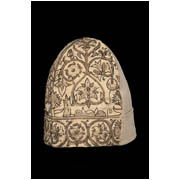Details
- Object type
cap; nightcap
- Place Associated
England (place of manufacture)
- Date
circa 1600-1620
- Materials
linen, silk, silver-gilt, hand-stitched
- Dimensions
overall: 230 mm x 255 mm
- Description
-
Man's cap or nightcap (part of) in linen embroidered in blackwork in black silk and silver-gilt threads worked in chain, stem, split, double Pekinese, open Ceylon, woven wheels and various buttonhole stitches in a pattern of coiling stems ending in flowers, borage, carnations, honeysuckles, and roses and leaves in a symmetrical pattern on each section of the crown and in row along the brim. Made from one piece of linen with brim with originally four conical sections along the top that would have formed the crown and a deep band along the bottom embroidered on the reverse before being folded up to form the brim. One half remains with two conical sections. Stems outlined in black silk thread worked in stem, split and chain stitch with the flowers and leaves in black silk thread worked in stem, split and chain stitch filled with black silk stitching (disintegrating) with details in silver-gilt thread worked in woven wheels, open Ceylon and various buttonhole stitches. Joins between the conical sections covered with plaited braid stitch.
Traditionally plain linen nightcaps were worn in bed at night. However, at the end of the 1500s and into the early 1600s embroidered nightcaps became popular. Their name of these embellished caps is a misnomer as these nightcaps were not worn in bed, but were a type of informal undress wear known as dishabille, a relaxed dress style worn at home. As nightcaps did not need to be individually tailored to individuals they were not made bespoke to order but could be purchased ready-made. Frances Seymour (1578–1639), Countess of Hereford, instructed her steward in 1603 to visit the best embroiderer of nightcaps ‘Mrs Price in the Strand’ and buy a ‘very fair one and not grossly wrought’ of ‘black silke and golde and silver’. In 1629 an Oxford student, William Freke, bought a ‘blackwork and gold cappe’ for 17s 6d, the equivalent of three weeks pay for a professional embroider.
This nightcap is embroidered with a monochromatic design known as blackwork. This style is thought to have originated in North Africa with early surviving examples from Egypt dating to the Mamluk period (1250–1517). The Umayyad Caliphate introduced the style to Spain where by the late 1400s it had spread from Mudéjar art into court dress. One of the earliest formal portraits depicting its use is Juan de Flandes, Isabel of Castille, circa 1500–04 (Palacio Real, Madrid). Isabel's daughter, Catherine of Aragon (1485–1536), is said to have introduced the style to England when she married Arthur Tudor (1486–1502), Prince of Wales, son of Henry VII (1457–1509), in 1501. Often referred to in England as Spanish work at this date, it can be seen decorating shifts in several early Tudor court portraits by Hans Holbein the Younger (circa 1497–1543) and his peers. By the late 1600s it was also being used to decorate accessories, main garments and domestic textiles.
The outline of the pattern on this nightcap is similar to embroidery designs in Thomas Trevelyon, Miscellany, 1608, which include several designs for men’s nightcaps. Blackwork nightcaps can be seen in contemporary portraits, including Marcus Gheeraerts the Younger (circa 1561/2–1636), Richard Tomlins (circa 1564–1650), 1628 (Bodleian Library, University of Oxford). As well as being decorated with floral motifs nightcaps could also be scented with flowers and herbs. William Turner, A Newe Herball, 1551, ‘judge[s] that the flowers of the Lavender ‘quilted in a cap and dayly worne are good for all diseases of the head that do come of a cold cause and they comfort the braine very well’.
Provenance: Royal School of Art Needlework, London; from where purchased by William Burrell on 31 December 1925 for £9.
- Credit Line/Donor
Gifted by Sir William and Lady Burrell to the City of Glasgow, 1944
- Collection
Burrell Collection: British Embroideries
- ID Number
29.136
- Location
In storage


